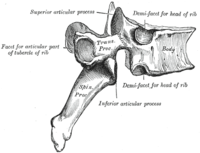
Photo from wikipedia
Background We sought to determine how frequently pubic root fracture is incorrectly identified as anterior column fracture by radiologists and describe differences in characteristics and outcomes between injury patterns. Methods… Click to show full abstract
Background We sought to determine how frequently pubic root fracture is incorrectly identified as anterior column fracture by radiologists and describe differences in characteristics and outcomes between injury patterns. Methods We identified 155 patients who sustained pelvic or acetabular fractures at a single, level 1 trauma academic institution. Pelvis computed tomography (CT) scans were evaluated to determine whether patients sustained an anterior column fracture or pubic root fracture. Demographic and clinical factors such as mortality, ambulatory status, type of treatment (nonoperative/surgery), and mechanism of energy were assessed. Results There were a total of 83 patients in the anterior column group and 72 patients in the pubic root cohort. Eighty-five percent of pubic root fractures were read as anterior column fractures by radiologists. A total of 77.8% of pubic root fractures had posterior ring involvement. Patients with true anterior column acetabular fracture were more likely to need surgery (63.86% vs 41.70%, P = 0.01) and be discharged to skilled nursing or inpatient rehabilitation (59.04% vs 40.27%, P = 0.02) compared to patients with pubic root fracture. Conclusion Pubic root fractures are frequently misread as anterior column fractures in radiology reports. Correctly diagnosing pubic root fractures and differentiating them from anterior column acetabular fractures can have significant impact on patients. Level of Evidence III, Therapeutic.
Journal Title: Journal of clinical orthopaedics and trauma
Year Published: 2021
Link to full text (if available)
Share on Social Media: Sign Up to like & get
recommendations!